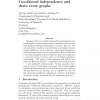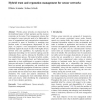306 search results - page 44 / 62 » Topological relationships between brain and social networks |
ECIS
2004
13 years 9 months ago
2004
E-collaboration is much more than the technological equivalent or substitute for traditional face-toface collaboration. The new metrics of time and distance modify, in essence, hu...
AI
2008
Springer
13 years 7 months ago
2008
Springer
Graphs provide an excellent framework for interrogating symmetric models of measurement random variables and discovering their implied conditional independence structure. However,...
BIOINFORMATICS
2011
13 years 2 months ago
2011
Motivation: High-throughput methods for detecting molecular interactions have produced large sets of biological network data with much more yet to come. Analogous to sequence alig...
JOCN
2011
12 years 10 months ago
2011
■ Previous studies suggested that the observation of other individualsʼ somatosensory experiences also activates brain circuits processing oneʼs own somatosensory experiences....
WINET
2010
13 years 6 months ago
2010
Wireless sensor networks are characterised by the distributed nature of their operation and the resource constraints on the nodes. Trust management schemes that are targeted at sen...


